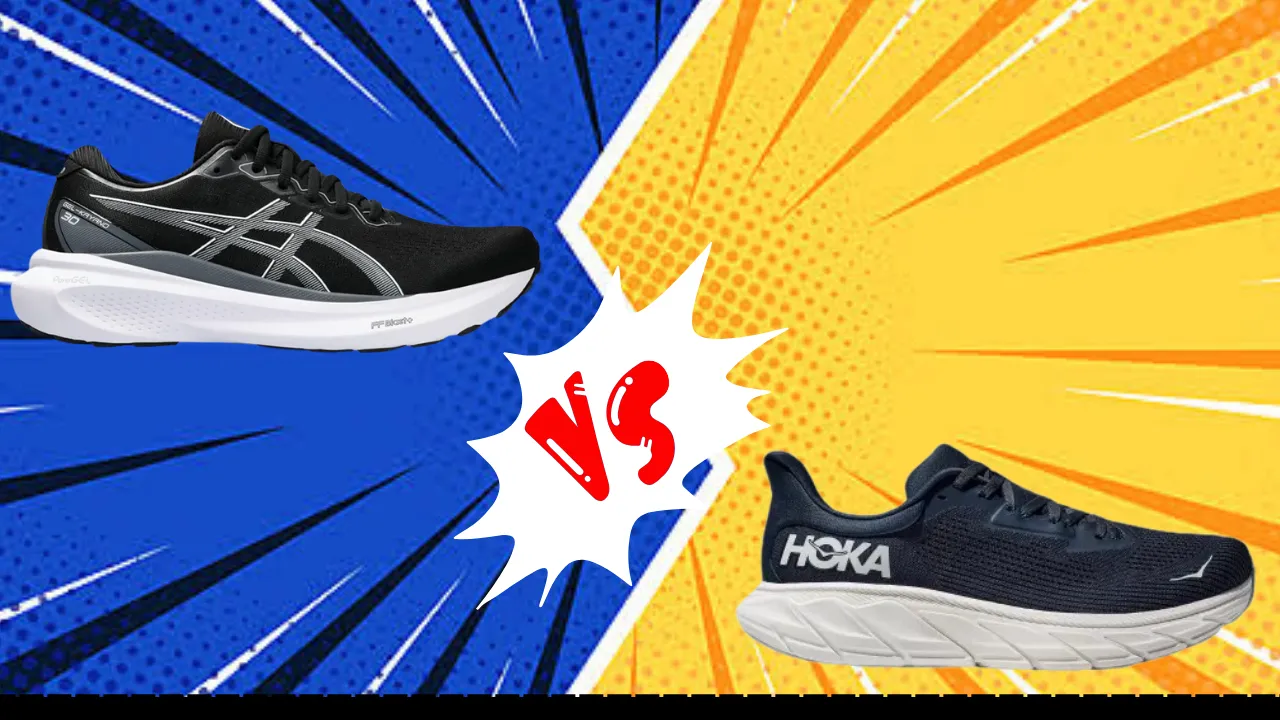The Asics Gel Kayano 30 and the Hoka Arahi 7 are both premium stability running shoes designed for runners who overpronate.
In this in-depth comparison, we’ll look at the key features of each shoe and how they stack up for performance in areas like walking, running, plantar fasciitis, and all-day standing.
Read on to find out which of these stability shoes is the better choice for your needs.
Similarities And Differences Between Asics Gel Kayano 30 and Hoka Arahi 7:
| Feature | Asics Gel Kayano 30 | Hoka Arahi 7 |
|---|---|---|
| Launched In | 2023 | 2024 |
| Stability | High (Dynamic DuoMax Support System) | Moderate (J-Frame technology) |
| Flexibility | Moderate | Moderate |
| Sizing | Men’s 7-13, Women’s 5-12 | Men’s 7-13, Women’s 5-11 |
| Weight | 10.6 oz (men’s), 9.3 oz (women’s) | 9.5 oz (men’s), 8.7 oz (women’s) |
| Cushion | High (FlyteFoam + FlyteFoam Propel + GEL) | Moderate (CMEVA foam) |
| Outsole | Rubber | Zonal rubber |
| Midsole | FlyteFoam + FlyteFoam Propel + GEL | J-Frame, CMEVA foam |
| Upper | Jacquard mesh | Mesh |
| Retail Price | $160 | $145 |
Features Comparison:
Materials:
The Asics Gel Kayano 30 has a rubber outsole for durability, a FlyteFoam midsole for responsive cushioning, and a jacquard mesh upper for a secure and breathable fit. The midsole also contains Gel units for impact absorption.
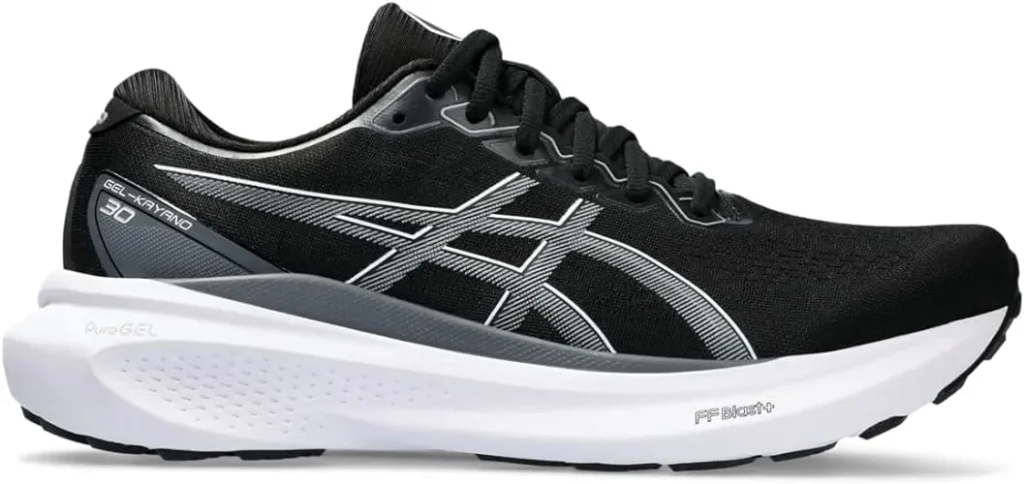
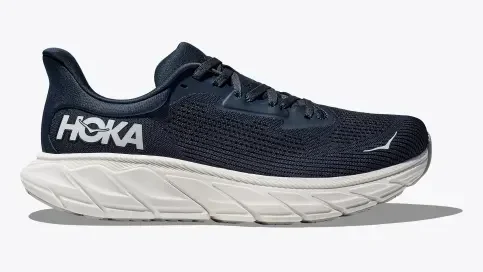
In contrast, the Hoka Arahi 7 has a zonal rubber outsole, a J-Frame and CMEVA foam midsole for stability and cushioning, and a mesh upper for breathability.
Both shoes use high-quality materials in their construction. However, Asics uses a greater variety of proprietary technologies like FlyteFoam and Gel to achieve its characteristic plush, stabilized ride.
Durability:
When it comes to durability, the Asics Gel Kayano 30 may have a slight edge. The Kayano line has been popular for over 30 years thanks to its proven sturdiness.
The rubber outsole and DuoMax support system on the Kayano 30 are built to handle many miles of pavement pounding. There have been some reports of the upper mesh wearing faster than expected though.
The Arahi 7 is also a durable shoe but not quite as robust as the Kayano. The zonal rubber outsole grips well and provides protection underfoot. The upper mesh is of decent quality but has been known to crease after moderate use.
Both shoes should hold up fine for daily training usage, but the Kayano 30 seems more likely to cross into high mileage territory.
Fit:
The Asics Gel Kayano 30 fits true to size for most runners. It has a wider toe box to accommodate wider feet. The redesigned upper mesh provides a supple, sock-like fit. The shoe runs on the heavier side though, which some runners didn’t like.
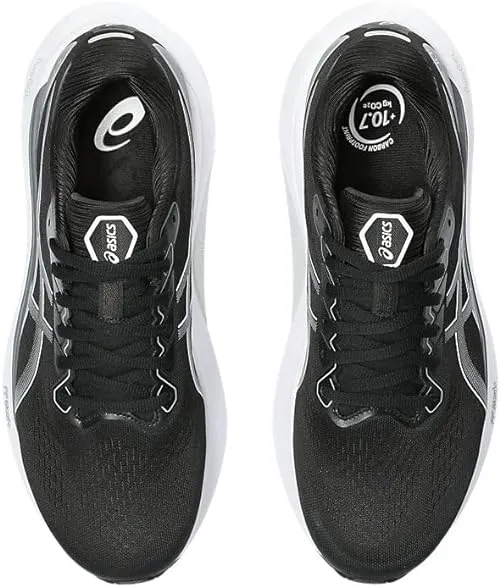
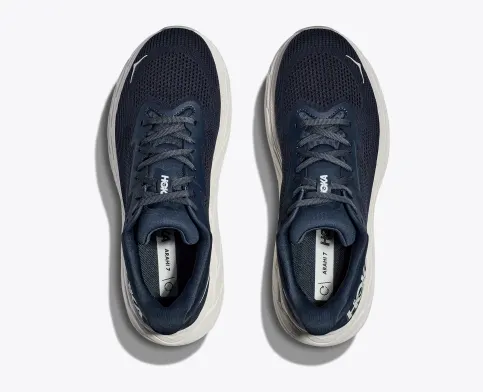
The Hoka Arahi 7 runs true to size but has a more spacious toe box for a comfortable fit. The upper mesh is soft and breathable straight out of the box. However, some found the midfoot design to be too shallow or tight. This caused some discomfort and rubbing for certain foot shapes.
Overall, the Arahi 7 may accommodate narrower feet better while the Kayano 30 gives a locked-in fit for average to wider feet. Considering an ideal balance of space and security, the Kayano 30 may have an edge in fit for more runners.
Stability:
With its Dynamic DuoMax support system and Guidance Trusstic technology, the Asics Gel Kayano 30 provides excellent stability for overpronators. It helps guide the foot through the gait cycle and prevent excess inward rolling. The firm midsole also contributes to a stable platform underfoot.
In comparison, the Hoka Arahi 7 has moderate stability from its early-stage meta-rocker design and J-Frame technology. It still allows for some natural movement though. Runners who need heavier guidance appreciated the Kayano 30 more in this area.
However, for those looking for just moderate stability without as much correction, the Arahi 7 struck the right balance. For runners with severe overpronation, the Kayano 30 is likely the safer choice for preventing injury. But the Arahi 7 gives a more natural feel.
Cushioning:
With its FlyteFoam Propel foam and Gel cushioning units, the Asics Gel Kayano 30 provides incredibly plush cushioning without feeling mushy. The supple foam absorbs shock effectively to reduce impact. Runners reported loving the pillowy soft ride.
The Hoka Arahi 7 is moderately cushioned with its CMEVA foam midsole. It provides a comfortable underfoot feel but not to the luxurious extent of the Kayano 30. The Kayano also better maintains its cushioning over miles, while some found the Arahi to flatten out over time.
For runners wanting maximal, marshmallow-like cushioning, the Kayano 30 is the clear winner. But for those who prefer a lower profile, more responsive ride, the Arahi 7 strikes a nice balance. The Kayano caters to comfort seekers, while the Arahi suits runners who still want a ground feel.
Value:
With a retail price of $160, the Asics Gel Kayano 30 is a premium-priced stability shoe. But it delivers excellent durability, cushioning, and support to justify the cost of serious overpronators.
The $145 Arahi 7 is still pricey but saves you $15 upfront. Considering its solid performance across the board, it is likely the better value for runners who want great features without breaking the bank.
While the Kayano 30 excels in areas like plush cushioning and stability, the Arahi 7 isn’t far behind at a more palatable price point. Unless you require Kayano’s maximalist cushioning and stability, the Arahi 7 gives you great bang for your buck. For most overpronators, the Arahi 7 strikes the best balance of quality and value.
Performance Comparison:
Walking:
For walking and casual wear, both shoes perform quite well thanks to their ample cushioning. The Asics Gel Kayano 30 feels ultra-plush underfoot, absorbing shock with each step. Its spacious forefoot also allows toes to splay naturally when walking.
Meanwhile, the Arahi 7 offers cushioning that is soft yet still responsive. Its roomy toe box is also an asset for walkers. Either shoe can handle fitness walking, runs to the grocery store, or all-day wear around town.
For pure cushioning comfort, the Kayano 30 is hard to beat. But the Arahi 7 still shines as a versatile walking shoe.
Running:
When it comes to running performance, the Asics Gel Kayano 30 shines for long, slow mileage thanks to its luxurious cushioning. The soft midsole and smooth transition make it easy to rack up the miles. However, some found it lacked responsiveness for tempo runs or speedwork.
Meanwhile, the Hoka Arahi 7 offers a moderately cushioned and stable ride that can pick up the pace when needed. It has enough pop for faster training days but doesn’t beat up your legs over long distances. The Arahi also handles turns and corners better due to its lower profile.
For recovery runs and logging daily miles, the Kayano’s cloud-like cushioning brings comfort. But if you want a shoe to handle speed as well, the Arahi 7 takes the lead.
Plantar Fasciitis:
The plush cushioning of the Asics Gel Kayano 30 helps minimize pain from plantar fasciitis when walking or running. It provides ample shock absorption and support in the rearfoot, key for PF relief.
While not as cushioned, the Hoka Arahi 7 is also a good option. Its moderately soft midsole still blunts impact to reduce strain on the plantar fascia, while the Meta-Rocker geometry encourages a smooth heel-to-toe transition.
For the ultimate in luxurious, pain-relieving cushioning, the Kayano 30 wins out. But the Arahi 7 can also aid PF recovery.
Standing All Day:
Cushioning and support are key for standing all day, making both shoes suitable options. The Asics Gel Kayano 30 offers superior cushioning to keep feet comfortable even after hours of wear. Its spacious forefoot also relieves pressure.
The Hoka Arahi 7 has ample but slightly firmer cushioning for all-day wear. It also has a roomy, breathable upper to keep feet fatigue-free.
For the highest level of cushioning during prolonged standing, the Kayano 30 delivers sublime comfort. But the Arahi 7 isn’t far behind.
Final Verdict:
For runners who overpronate, the Asics Gel Kayano 30 and Hoka Arahi 7 both perform well as premium stability running shoes.
The Kayano 30 stands out for its luxurious cushioning and maximum stability, while the Arahi 7 strikes a nice balance of comfort, support, and value.
Consider your needs for cushioning, stability, and budget to choose the best option. But you can’t go wrong with either of these well-crafted stability shoes.

